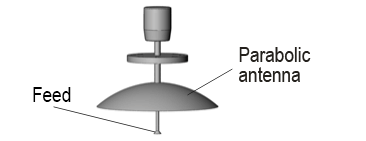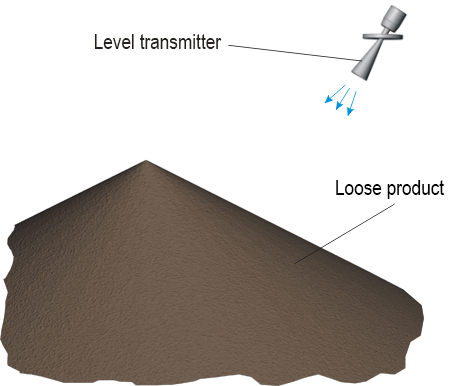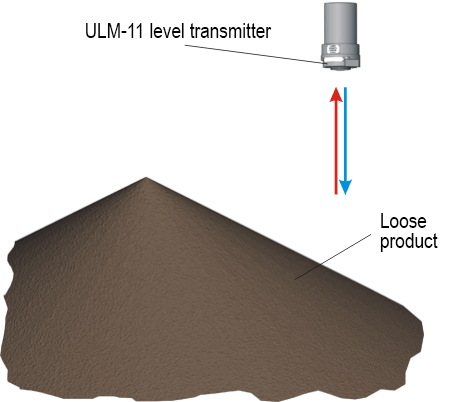Level Measurement of Loose Materials
Radar ULM level transmitters are used to measure the level both of liquids and loose minerals. The ULM level transmitters measure levels of cement, gypsum, sand, crushed stone, coal, coal dust, carbon black (soot), polypropylene, ore, components of material fertilizers, apatite, grain, compound feed, etc.
The major advantage of ULM radar level transmitters as compared to similar models of other manufacturers is the highest sensitivity and selectivity, that is, capability to steadily operate in weak reflection conditions and insensitivity to false echo.
When resolving tasks of measuring the level of loose materials, the noncontact radar level transmitter has obvious advantages as compared to other methods: with contact methods, a measurement element fails sooner or later while with laser level transmitters the measurements are impossible in dusty conditions as there is no direct visibility, so the laser fails to “make its way through” to the product.
The radar method of level measurement ensures dust insensitivity within the space between the antenna and the product. As opposed to the ultrasound (acoustic) level transmitter, the radar one measures the delay time of the reflected electromagnetic wave rather than sound wave (the latter dissipates in the dust cloud).
Application specifics
Unlike liquid products, an air/product interface of loose materials is uneven. Therefore, the level measurement error is determined by the dimension of irregularities (centimetre units) on the surface rather than by the level transmitter's inherent error (millimetre units).
As the reflected signal from a loose material is weaker than that from a liquid product (due to its uneven surface), operation stability of the radar level transmitter will depend on its sensitivity. In conditions of weak reflected signals, continuous level transmitters (FMCW radars) prove themselves best as they perform measurements using the probing-signal frequency independent from its amplitude.
An additional factor that affects the level measurement process for loose materials is formation of either a taper on the product surface during loading or a conical dimple during discharge. This additionally weakens the reflected signal, the major portion of which reflects sideward, so, if the surface of the loose product were smooth, measurement would be very problematic. However, as the product surface is uneven, reflections from it have various directions; the more sensitive the level transmitter, the better its ability to process a weak reflected signal and the more stable its operation.
How to increase the sensitivity
Since the loose material's reflectance is low, losses of the reflected signal shall be reduced by focusing the emitted energy on a certain surface area to minimize losses due to natural dissipation of the reflected signal. Many manufacturers of radar level transmitters therefore have to measure the level in high hoppers using level transmitters with a parabolic antenna, which ensures the beam width of 6–100.

However, this method has its disadvantages: first, the parabolic antenna is a massive structure, which requires a hole with a large inside diameter in the hopper roof and makes the level transmitter much more expensive; second, dust very often clogs an offset feed located below the antenna, which makes level measurement impossible.
A method of tilted level-probe installation is also used. The level probe has a movable on-flange fastening to tilt it. Thus, we can find the optimal instrument tilt to ensure the best reflection from the product surface.

An apparent disadvantage of this method is that the chosen level-transmitter tilt will be optimal only for one position of the product level, and when it changes (loading/discharge) the situation will be different and probably not optimal at all. This method aims to compensate insufficient sensitivity of the level transmitter and is typical of pulse level transmitters.
ULM level transmitters
When measuring the level of loose materials, the ULM level transmitters do not require a parabolic antenna. The product range of ULM level transmitters consists of various modifications with a beam width of 40, 150, or 220, which covers all necessary level measurement ranges for loose materials. For instance, a beam width of the ULM-11 level transmitter is 40, which ensures the narrowest beam among all existing radar level transmitters in the market. No need for large holes in the hopper roof! No need for the complicated installation place structure to achieve a level-transmitter tilt!

Thus, electromagnetic energy focuses as much as possible on a certain product area with minimum “waste” dissipation. The reflected signal returns to the level transmitter's antenna. But when measuring levels of loose materials, other things being equal, the reflected signal will be significantly weaker that when measuring liquid levels. Therefore, stable measurements require high sensitivity of the level transmitter.
In this case, you can see another advantage of the ULM level transmitters' structure: a signal reflected from the loose-material surface has low amplitude, and level measurement by the pulse measurement method will be extremely difficult as a key role in normal operation of the pulse level transmitter belongs to the reflected-signal amplitude. But ULM level transmitters use the adaptive FMCW method, where the reflected-signal amplitude is of secondary importance as the level information is carried by the frequency. Therefore, if reflection from the product exists and is “visible” against air noises, the level will be measured!
LIMACO's proprietary technologies and algorithms ensure guaranteed level measurement of complex loose products, such as soot, coal dust, and components of mineral fertilizers. All you need to do is to correctly select the level transmitter model and configuration based on a questionnaire.